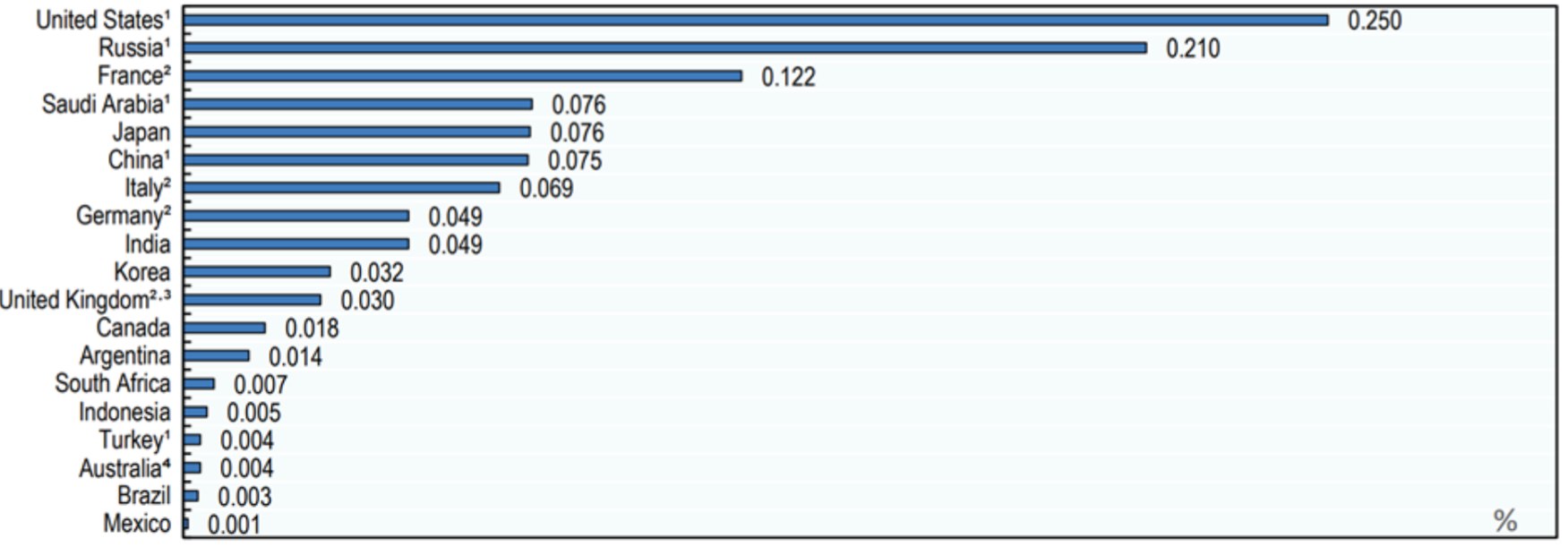Introduction
Countries worldwide are competing in the race to explore the solar system, aiming to make their mark as space pioneers. India, one of fastest growing economies in the world, embarked on an impressive achievement with Chandrayaan 3 and brought the nation into the global spotlight in this exciting endeavor. India’s success on the moon is especially significant, given that it has surpassed even some of the world’s biggest economies. This highlights India’s growing strength in space technology and its role in interstellar exploration, marking a major milestone for the country and placing it prominently on the global space exploration stage. A large chunk of countries across the globe have been increasing investments in many space activities, in particular funding traditional activities, such as space science, space manufacturing and launch. The graph below sourced from OECD Paper for the G20 Space Economy Leaders’ Meeting Shows various government’s space budget as a share of GDP.

Beyond the applause for space accomplishments, there’s a question we don’t often think about: What’s the economic significance? Space economics studies the money side of things, like space exploration, satellites, and space use. It’s a wide area with lots to discover. The Space Economy is defined by OECD as the full range of activities and the use of resources that create value and benefits to human beings in the course of exploring, researching, understanding, managing, and utilizing space.
Growth of Space Industry: A Giant Leap
The space economy is expanding and evolving as the space sector develops and becomes more deeply intertwined with society and the economy. The existing space infrastructure enables creation of new services, which, in turn, open up fresh opportunities in various areas, including meteorology, energy, telecommunications, insurance, transportation, maritime, aviation, and urban development. This, in turn, leads to additional economic and societal advantages.

- Global Growth: The charts provided by McKinsey and Company insights illustrate a remarkable expansion of the global space sector. The space market has experienced rapid growth and is projected to double in size by 2030. Furthermore, private investments are anticipated to rise by eighty percent by 2030, signaling substantial profit prospects within the space industry.
- Growth: The Indian Context: A study conducted by the Indian Institute of Space Science and Technology (IIST) and the Centre for Development Studies (CDS) highlights the evolving state of India’s space economy. The sector is set for expansion, driven by national policies, increased private investment, and deeper integration with the global private space industry. The research, published by Elsevier, reveals that the space economy now contributes around 0.23% of the country’s GDP. The study anticipates a rise in space-related startups due to favorable policies and the maturation of space technologies, with lower entry barriers and a growing startup ecosystem. Existing startups predominantly focus on launch vehicles, satellite systems, and applications, with many located in Bengaluru, where the Indian Space Research Organisation (ISRO) is based. The New Space India Limited (NSIL) is expected to facilitate further technology transfers, fostering the creation of more startups in the future.
Economic and Social Contributions
- Contributions to innovation and entrepreneurship: People are becoming more interested in how government space programs can help the economy, especially in areas like innovation and starting new businesses. Government space research and development programs, especially in areas like space travel and using space for various purposes like launching rockets, observing Earth, and exploring space, have unique qualities that make them very helpful for sharing knowledge and technology with companies and organizations that take part in these programs.Government agencies are also increasing their support for startups and entrepreneurship in the space industry. For example, the UK Satellite Applications Catapult in the Harwell space cluster helps UK startups, and the French Booster program supports specific activities in coordination with existing technology clusters.
- Monitoring the climate and the environment: NASA relies on the Atmospheric Infrared Sounder tool aboard the Aqua satellite, which orbits Earth at an altitude of about 700 kilometers. This satellite mission was initiated in 2002 and is a key component of NASA’s climate assessments. Space-based observations are of utmost importance in researching and overseeing climate changes. They make significant contributions to over half of the 54 vital climate factors that the global scientific community currently utilizes to describe Earth’s climate.
- Bridging the Digital Divide: Broadband provided via satellites is a technology that has the potential to offer internet connectivity in regions where other land-based options are either unavailable or too costly to establish. Additionally, there are ongoing efforts to introduce new services in such areas.
- Providing Development Assistance: Space technologies are now being more frequently employed for the purpose of providing development assistance. This form of official development assistance (ODA) related to space includes activities like offering technical support in areas such as telemedicine and geographic information systems. G20 economies have collectively pledged around USD 650 million for space-related ODA between 2000 and 2018, with a significant focus on benefiting economies in Far-East Asia and Sub-Saharan Africa.
Problems related to Space Economics
- Access to Space: Reducing the cost of accessing space remains a priority. Achieving cost-effective launch solutions and expanding launch capacity are essential for the continued growth of the space economy.
- Sustainability: As the space economy expands, it must prioritize environmental sustainability and responsible space practices to minimize the impact on the space environment and Earth.
- Government regulations: The space sector faces a complex regulatory landscape, with international agreements and treaties that oversee matters like managing space debris, allocating spectrum, and controlling space traffic. Creating well-structured and flexible regulatory systems is crucial to ensure long-term and sustainable growth in the industry.
References
- Pant, M. (2023, July 26). India’s space economy could potentially touch $100 billion by 2040, says new global report. Business Today. https://www.businesstoday.in/latest/in-focus/story/indias-space-economy-could-potentially-touch-100-billion-by-2040-says-new-global-report-391400-2023-07-26
- Pumping the brakes on used-car prices. (2023, October 6). McKinsey & Company. https://www.mckinsey.com/featured-insights/sustainable-inclusive-growth/chart-of-the-day/pumping-the-brakes-on-used-car-prices
- SPACE ECONOMY FOR PEOPLE, PLANET AND PROSPERITY. (n.d.). OECD Paper for the G20 Space Economy Leaders’ Meeting.
- Space, the Final Economic Frontier. (n.d.). Journal of Economic Perspectives—Volume 32, Number 2—Spring 2018—Pages 173–192. https://www.hbs.edu/ris/Publication%20Files/jep.32.2.173_Space,%20the%20Final%20Economic%20Frontier_413bf24d-42e6-4cea-8cc5-a0d2f6fc6a70.pdf
- The Hindu Bureau. (2022, December 4). Space economy poised for expansion, indicates study. https://www.thehindu.com/news/national/kerala/space-economy-poised-for-expansion-indicates-study/article66223395.ece/amp/
- What is the Space Economy? (n.d.). https://space-economy.esa.int/article/33/what-is-the-space-economy


Recent Comments